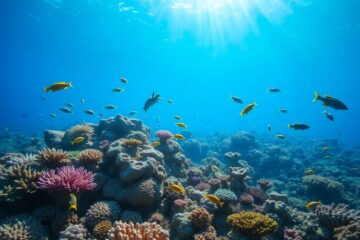The European Green Deal represents a pivotal step towards combating climate change and achieving climate neutrality by 2050. This comprehensive plan, set forth by the European Commission, outlines ambitious goals aimed at transforming the European Union’s economy into a more sustainable and environmentally friendly model.
Through a series of bold initiatives and policies, the European Green Deal seeks to address the most pressing environmental challenges of our time, such as reducing greenhouse gas emissions, promoting renewable energy sources, and fostering a circular economy. By unveiling these ambitious goals, the European Union is setting a global example for how nations can work together to combat climate change and build a more sustainable future for all.
Table of Contents
The European Green Deal Explained
Ambitious and comprehensive, the European Green Deal is a roadmap designed to tackle climate change and transform the European Union into a sustainable, climate-neutral economy. This initiative, launched by the European Commission in December 2019, aims to address global warming and environmental degradation by reshaping policies and regulations at the European level.
Definition and Key Objectives
For the European Green Deal, climate neutrality by 2050 is the ultimate goal. This means that the EU’s greenhouse gas emissions will be reduced to net-zero, ensuring that the amount of carbon dioxide released into the atmosphere is balanced by the amount removed. To achieve this, the Deal focuses on areas such as energy efficiency, renewable energy, sustainable transport, and biodiversity protection.
Key objectives of the European Green Deal include reducing greenhouse gas emissions, transitioning to a circular economy, and preserving Europe’s natural ecosystems. By promoting a more sustainable way of living and consuming, the Deal aims to lead the EU towards a cleaner, greener future.
The Timeline for Implementation
For the European Green Deal, a roadmap has been outlined to guide the EU’s transition towards climate neutrality by 2050. This includes setting intermediate targets for 2030 to ensure progress is being made at regular intervals. By 2030, the EU aims to reduce greenhouse gas emissions by 50-55% compared to 1990 levels, as well as increase the share of renewable energy and improve energy efficiency.
European countries will need to make significant investments in renewable energy infrastructure, sustainable agriculture, and eco-friendly transportation to meet the targets set out in the Deal. Collaboration between governments, industries, and citizens will be crucial in driving the necessary changes to achieve a more sustainable and environmentally friendly future for Europe.
Legal Framework and Policy Measures
Some of the key elements of the European Green Deal are enshrined in binding legislative acts that aim to drive the transition towards a more sustainable and resilient economy. These legislative acts set clear targets and deadlines for reducing greenhouse gas emissions, increasing energy efficiency, and promoting the use of renewable energy sources.
Binding Legislative Acts
An integral part of the European Green Deal is the Climate Law, which sets the ambitious goal of achieving climate neutrality by 2050. This legislation establishes a legally binding commitment for the EU to reach net-zero greenhouse gas emissions by mid-century. Additionally, the Climate Law includes an interim target of at least a 55% reduction in emissions by 2030 compared to 1990 levels, highlighting the EU’s commitment to accelerating its efforts to combat climate change.
Furthermore, the European Green Deal encompasses the Circular Economy Action Plan, which seeks to promote the circular economy model through a series of regulatory measures. The plan includes initiatives to improve the design, production, and recycling of products, as well as measures to reduce waste and promote sustainable consumption. By transitioning to a more circular economy, the EU aims to reduce resource use, minimize environmental impact, and foster innovation and competitiveness.
Financial Mechanisms and Investments
Financial mechanisms and investments play a crucial role in the implementation of the European Green Deal, providing the necessary resources to drive the transition to a climate-neutral economy. Investments in sustainable projects and technologies are essential for achieving the EU’s climate goals and promoting green growth. The European Green Deal Investment Plan aims to mobilize at least €1 trillion of sustainable investments over the next decade, funding initiatives that contribute to reducing emissions, improving energy efficiency, and protecting biodiversity.
Sector-Specific Goals and Strategies
Renewable Energy and Decarbonization
Strategies to promote renewable energy and decarbonization are central to the European Green Deal’s ambitious goals. The plan aims to increase the share of renewable energy sources in the EU’s energy mix to at least 32% by 2030, with a significant focus on wind, solar, and hydropower. Additionally, decarbonizing the energy sector involves phasing out coal as a power source and supporting the growth of clean energy technologies such as hydrogen and geothermal power.
Investing in renewable energy infrastructure, improving energy efficiency, and integrating energy systems across EU countries are key components of the strategy. By accelerating the transition to a low-carbon economy, the EU aims to not only reduce greenhouse gas emissions but also create new job opportunities and drive sustainable economic growth.
Sustainable Transport and Mobility
An emphasis on sustainable transport and mobility plays a crucial role in achieving the European Green Deal’s objectives. The plan targets reducing emissions from the transport sector by at least 90% by 2050 and aims to make Europe a leader in clean and digital transport solutions. Strategies include promoting the use of electric vehicles, expanding public transportation networks, and increasing the efficiency of freight logistics.
Plus, fostering sustainable urban mobility and investing in infrastructure for cycling and walking are priorities to reduce emissions and improve air quality in cities. By encouraging the adoption of alternative fuels and sustainable transport modes, the EU seeks to transform the way people and goods move, contributing to a greener and healthier future for all.
Boosting Energy Efficiency
Now more than ever, the need to enhance energy efficiency is crucial in our journey towards achieving climate neutrality. The European Green Deal places a strong emphasis on boosting energy efficiency across various sectors to reduce greenhouse gas emissions and transition towards a cleaner, more sustainable future.
Building Renovations and Retrofitting
Energy efficient buildings are essential in reducing energy consumption and emissions. The European Green Deal focuses on promoting building renovations and retrofitting to improve energy performance and decrease the carbon footprint of existing structures. By enhancing insulation, upgrading heating and cooling systems, and implementing advanced technologies, buildings can become more energy efficient and environmentally friendly.
These renovations not only contribute to a significant reduction in energy usage but also enhance the comfort and quality of living spaces. By investing in building renovations and retrofitting, we can create a more sustainable built environment and move closer to achieving climate neutrality by 2050.
Industrial Innovation and Circular Economy
The European Green Deal also highlights the importance of industrial innovation and the transition towards a circular economy. By promoting sustainable production processes, resource efficiency, and waste reduction, industries can significantly decrease their environmental impact and contribute to the overall goal of climate neutrality.
Industrial symbiosis, where waste from one industry becomes a valuable resource for another, plays a crucial role in moving towards a circular economy. By fostering innovation and collaboration within industries, we can create a more sustainable and efficient economic model that benefits both the environment and businesses.
Protecting Biodiversity and Ecosystems
Despite the alarming rate at which biodiversity is being lost due to human activities, the European Green Deal is committed to protecting and restoring nature for future generations. Preserving biodiversity and ecosystems is crucial for maintaining a healthy planet and achieving climate neutrality.
Farm to Fork Strategy for Sustainable Food
Sustainable food production is at the core of the Farm to Fork Strategy, which aims to ensure a transition towards a more sustainable food system. By promoting agroecology, organic farming, and reducing the use of pesticides and antibiotics, the strategy seeks to improve food quality, protect the environment, and support local farmers.
The Farm to Fork Strategy also emphasizes the importance of reducing food waste, promoting sustainable consumption patterns, and investing in research and innovation for sustainable agriculture. By encouraging a shift towards plant-based diets and promoting sustainable food choices, the strategy aims to reduce the environmental impact of food production.
Biodiversity Strategy for 2030
To
Fork The Biodiversity Strategy for 2030 sets ambitious targets for the protection and restoration of biodiversity and ecosystems. By addressing key drivers of biodiversity loss, such as land use change, pollution, and climate change, the strategy aims to halt biodiversity loss and restore ecosystems by 2030.
The Role of Citizens and Communities
Public Awareness and Participation
Not to be overlooked in the European Green Deal’s ambitious goals is the critical role of public awareness and citizen participation. Any successful transition to a sustainable future heavily relies on the engagement and support of individuals and communities across Europe. By fostering a culture of environmental consciousness and involving citizens in decision-making processes, the European Union aims to create a sense of shared responsibility towards achieving climate neutrality.
Public awareness campaigns, educational programs, and information dissemination are key components of the European Green Deal. These initiatives seek to empower citizens with knowledge about sustainable practices and the impact of their daily choices on the environment. By encouraging active participation in climate-related initiatives and promoting sustainable lifestyles, the EU aims to mobilize a collective effort towards a greener future.
Climate Pact and Educational Initiatives
To further strengthen community involvement and ensure long-term sustainability, the European Green Deal proposes the establishment of a Climate Pact and educational initiatives. Communities will be encouraged to take concrete actions to reduce emissions, promote renewable energy sources, and enhance energy efficiency in their localities. Educational programs will also play a crucial role in equipping citizens with the necessary tools and knowledge to contribute effectively to the fight against climate change.
Communities will have the opportunity to join forces with governments, businesses, and civil society to develop innovative solutions and sustainable practices. Through the Climate Pact, local initiatives will be supported financially and logistically to accelerate the transition to a carbon-neutral economy. Educational initiatives will focus on raising awareness about climate issues, nurturing a new generation of environmentally conscious citizens, and fostering a culture of sustainability from an early age.
Challenges and Critiques
Economic and Political Hurdles
Unlike the straightforward nature of the European Green Deal’s goals, achieving climate neutrality poses significant economic and political challenges. Implementing the necessary changes to reach the ambitious targets will require substantial investments in renewable energy infrastructure, technology development, and the restructuring of industries. This transition may lead to job displacements in traditional sectors, which could be met with resistance from labor unions and local communities.
Any shift towards a greener economy also brings about concerns regarding the potential impacts on competitiveness in the global market. European industries may face increased costs as they strive to comply with stricter environmental regulations, putting them at a disadvantage compared to regions with laxer standards. This could lead to a scenario where companies relocate production to countries with lower environmental standards, resulting in a phenomenon known as carbon leakage.
Balancing Member States’ Interests
Challenges in balancing the interests of all EU member states also present a significant obstacle to the successful implementation of the European Green Deal. Each country has its own unique economic structure and energy mix, making a ‘one size fits all’ approach difficult to apply. Some nations heavily rely on fossil fuels for energy production, while others have already made substantial progress in transitioning to renewables.
For instance, Central and Eastern European countries with coal-dependent economies may struggle to meet the same climate targets as countries with a more diversified energy portfolio. The disparities in economic development and historical energy choices among member states could create tensions within the EU, hampering the collective efforts to achieve climate neutrality.
The European Green Deal in Global Context
Not only does the European Green Deal aim to transform the European Union into a climate-neutral continent by 2050, but it also plays a crucial role in the global fight against climate change. The goals and strategies outlined in the deal are not only ambitious but also set a standard for other countries and regions to follow in the journey towards a sustainable future.
International Collaboration and Leadership
Deal
The European Green Deal emphasizes the importance of international collaboration and leadership in combating climate change. By engaging with global partners, the EU seeks to drive collective action on climate issues, encourage the adoption of sustainable practices worldwide, and strengthen international climate governance. Through its leadership role, the EU aims to inspire other nations to raise their ambitions and commit to decisive climate action.
Comparisons with Other Climate Initiatives
International
| European Green Deal | Other Climate Initiatives |
| The European Green Deal sets binding targets and timelines for achieving climate neutrality. | Some other climate initiatives lack specific targets or enforceable timelines, leading to uncertainties in implementation. |
| The deal encompasses various sectors, including energy, transport, and agriculture, to ensure a comprehensive approach to sustainability. | Other initiatives may focus on specific sectors or aspects of climate change, potentially leaving gaps in addressing the broader challenges. |
Plus
| Important Details | Dangerous Details |
| The European Green Deal’s focus on innovation and green technologies aims to drive economic growth and create new job opportunities in the green sector. | Failure to meet the ambitious targets outlined in the deal could lead to severe environmental consequences, including increased climate impacts and biodiversity loss. |
Monitoring, Reporting, and Review Mechanisms
As the European Green Deal sets out to transform the European economy into a sustainable and climate-neutral one, monitoring, reporting, and review mechanisms play a crucial role in ensuring accountability and transparency in the implementation process.
Transparency and Accountability
Reporting on the progress towards the European Green Deal’s ambitious goals will be transparent and accessible to the public, with regular updates on key milestones and targets. This transparency breeds accountability among member states and stakeholders, fostering a sense of collective responsibility towards achieving climate neutrality by 2050.
Progress Indicators and Benchmarks
Transparency in defining clear progress indicators and benchmarks is essential for tracking the effectiveness of the European Green Deal initiatives. These metrics provide a concrete way to measure the impact of policies and actions taken to reduce greenhouse gas emissions and transition to a greener economy.
It is imperative that the progress indicators and benchmarks set by the European Green Deal are robust and scientifically sound, allowing for accurate assessment of the EU’s journey towards climate neutrality. By establishing clear targets and measuring tools, the EU can stay on course and make informed decisions to tackle the most pressing environmental challenges.
Summing up
Considering all points discussed, the European Green Deal has outlined ambitious goals for achieving climate neutrality by 2050. Through a comprehensive strategy that includes reducing greenhouse gas emissions, investing in sustainable technologies, and protecting biodiversity, the EU aims to become a global leader in the fight against climate change.
The success of the European Green Deal will rely on the cooperation of member states, industry stakeholders, and citizens to implement the necessary changes to achieve these goals. Nowadays the case is discussed in parlaments of all members of the EU. Disscusion can be tracked f.e. on live stream from polish government online. By working together and embracing the transition to a greener economy, Europe can pave the way towards a more sustainable future for generations to come.
FAQ
Q: What is the European Green Deal?
A: The European Green Deal is a set of policy initiatives by the European Commission aimed at making Europe the world’s first climate-neutral continent by 2050.
Q: What are the key goals of the European Green Deal?
A: The main goals of the European Green Deal include reducing greenhouse gas emissions, investing in green technologies, preserving biodiversity, and creating a circular economy.
Q: How does the European Green Deal plan to achieve climate neutrality?
A: The European Green Deal plans to achieve climate neutrality by implementing various measures such as increasing renewable energy sources, promoting energy efficiency, and implementing stricter emissions standards.
Q: What are some of the challenges facing the implementation of the European Green Deal?
A: Some challenges facing the implementation of the European Green Deal include resistance from some member states, the high costs associated with transitioning to a greener economy, and the need for widespread societal behavioral change.
Q: How can individuals contribute to the success of the European Green Deal?
A: Individuals can contribute to the success of the European Green Deal by adopting sustainable practices in their daily lives, supporting businesses that prioritize environmental sustainability, and advocating for policies that promote climate action.

Our contributing author is a passionate advocate for eco-friendly living and sustainability. With a background in eco-life, they are dedicated to inspiring and empowering individuals to adopt environmentally conscious lifestyles. Through insightful articles, they share practical tips, innovative solutions, and thought-provoking perspectives to promote a greener, more sustainable world. Join them on the journey towards eco-smart living and discover how small choices can make a big impact. 🌱









